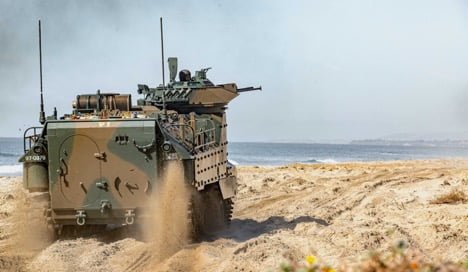As the Japanese focus on strengthening the perimeter of their defenses of Japan, new systems are being procured and modifications to platforms being made.
The purchase of Ospreys and F-35s both As and Bs, along with the modification of Japanese helicopter landing ships are entailed as Japan looks to its enhanced island defense.
At Iron Fist, the Japanese and USMC have worked closely together in evolving the skill sets involved in amphibiosity.
In an article published on February 19, 2020 by Gidget Fuentes the working relationship between Japan and the USMC was highlighted:
This year’s Iron Fist exercise marked the first time this group of 310 Japanese soldiers – 3rd Company with 2nd Amphibious Rapid Deployment Regiment Landing Team – launched from a ship and landed ashore in a coordinated mission alongside Marines, who earlier had launched their AAVs from the San Antonio-class amphibious transport dock USS Portland (LPD-27).
“We wanted to pursue the concept with them of ‘separate but synchronized,’ so headquarters and staffs working together and synchronizing,” Capt. Coleman Fuquea, an artillery officer and exercise planner with the 15th Marine Expeditionary Unit, told USNI News. “But on the tactical level, U.S. and our Japanese allies would fight in separate battle spaces.”
While a platoon of Marines and Japanese soldiers wouldn’t clear a building together, they would operate together with “separate objectives, separate battle spaces,” Fuquea said. Planners designed the scenarios with two main battle spaces – one Marine, one JGSDF – but with “a synchronized mission and synchronized staffs to facilitate that.”
The JGSDF light-infantry troops spent several weeks training with various I Marine Expeditionary Force units at Camp Pendleton’s ranges. Then they embarked their AAVs and trucks onto Portland and Pearl Harbor at Naval Base San Diego, Calif., and trained and rehearsed beach landings at the offshore training range on San Clemente Island before the Camp Pendleton beach landing….
The Japanese force wasn’t training to seize an island – Japan’s constitution prohibits offensive military operations – but rather is building and strengthening its capabilities for maritime security, including defending islands from an invading force. The scenario is a real and ongoing threat to Japan, an island-nation whose 3,000-plus islands include contested claims by China and other countries, including the disputed Senkaku Islands in the East China Sea.
Island defense is critically important, JGSDF officials said at the Jan. 21 opening ceremony, as activities along other fronts including North Korea and Russia threatens Japan’s security. Senior military leaders have been vocal, especially in recent years, over the seriousness of the threats that Japan faces, and particularly from China’s recent expansive operations across the region that have rattled its neighbors….
Like in prior years, San Diego-based Expeditionary Strike Group 3 is providing the logistical L-class ship lift for the soldiers, since no Japan Maritime Self-Defense Force vessels have participated in Iron Fist, although several JMSDF officials observed the exercise.
“It would be great in the future if we could get a Japanese L-class ship here,” Fuquea said, adding “what we’d really like to see in the future is force-on-force training and have the U.S. and the Japanese more of a sparring-partner relationship. That allows unit leaders… to get a thinking adversary.”
Incorporating that into Iron Fist training in coming years as the Japan continues to build and strengthen its ARDB working with the U.S., he added, “I think it would have radical benefits to us both.”
For the complete article, see the following:
Iron Fist Teaching Japanese Amphib Force to Synch with U.S. Marines


